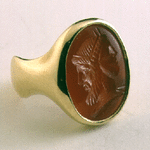Carnelian Intaglio Depicting Zeus, 1700 CE - 1800 CE
Carnelian/Gold
FJ.5996
The art of glyptics, or carving on colored precious stones, is probably one of the oldest known to humanity. Intaglios, gems with an incised design, were made as early as...
The art of glyptics, or carving on colored precious stones, is probably one of the oldest known to humanity. Intaglios, gems with an incised design, were made as early as the fourth and third millennia B.C. in Mesopotamia and the Aegean Islands. They display a virtuosity of execution that suggests an old and stable tradition rooted in the earliest centuries. The tools required for carving gems were simple: a wheel with a belt-drive, a set of drills, and abrasives, absolutely necessary since the minerals used were too hard for a metal edge to leave as much as a scratch on them. A special difficulty of engraving intaglios, aside from their miniature size, was that the master had to work with a mirror image in mind. The creation of gems was a great exploit, done for a love of the beautiful. The hardness of the minerals made them truly everlasting. Today they remain as fresh as ever, unaffected by the flow of centuries. The ancient masters of glyptics used a wide range of themes, which reflected literally every aspect of the spiritual and material culture of the ancient world: politics, religion, literature, theater, mythology and everyday life. In some cases miniature gems are the only source of information on the life of the ancient world. Most valuable among these are reproductions of lost masterpieces of Greek painting and plastic art. This exquisite intaglio is most probably a reproduction of a classical intaglio. Ancient glyptics reached full bloom in the classical period. Gems of this time, with their profoundly humanistic approach, their precise outlines, the freedom and perfection of the composition and splendid quality of the stones, are true masterpieces. The Classical Revival artist has, with exceptional skill and love for beauty, engraved this intaglio with the same perfection that the classical Romans displayed. The flowing outline of the oval confines the space wherein the magnificent bust of the mythological Zeus and Athena is engraved. Athena is depicted emerging from her father's head. Zeus was suffering from a terrible headache and gave birth to Athena when Prometheus opened his skull with a double axe. Athena is said to have sprung forth from his head wearing golden armor. Here, Zeus and Athena are shown in profile. We cannot help admiring the fine, thin lines of the design, created as though with only the lightest touches of the tool. It is a true masterpiece that has captured the timeless essence of perfection and beauty.



